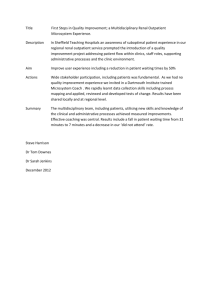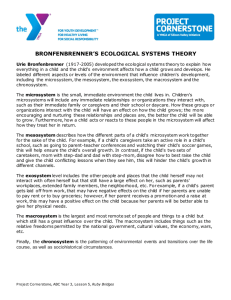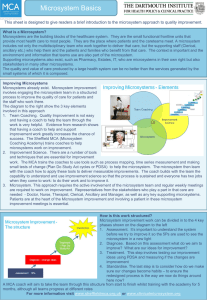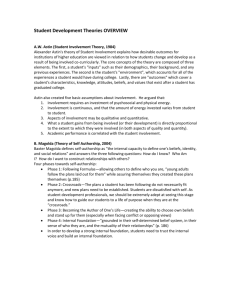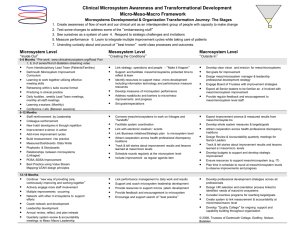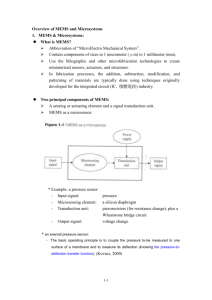Microsystems at a Glance: Healthcare Quality Improvement Guide
advertisement
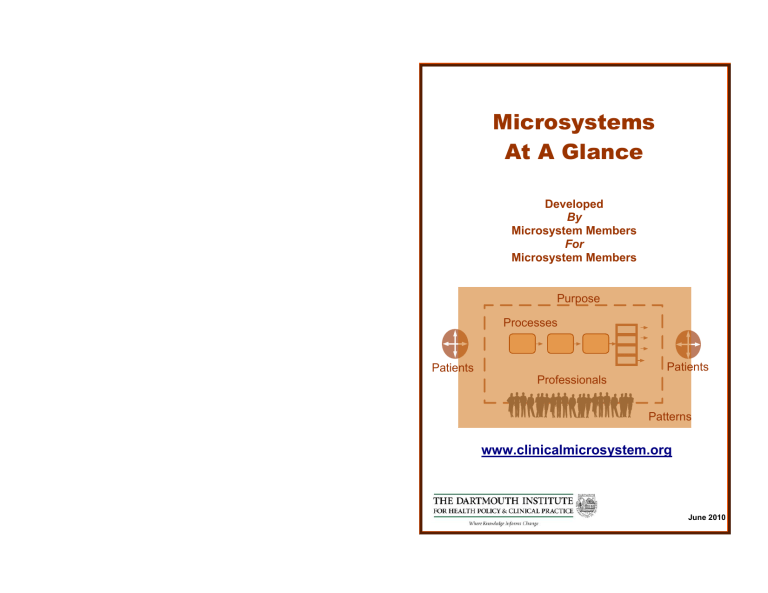
Microsystems At A Glance Developed By Microsystem Members For Microsystem Members Purpose Processes Patients Patients Professionals Patterns www.clinicalmicrosystem.org June 2010 2 This “Microsystems At A Glance” was initially developed by colleagues from Lucile Packard Children’s Hospital at Stanford University Medical Center in Palo Alto, California in an effort to provide the “big picture” and overview of microsystem development to new members engaging in the developmental journey. The original document has been circulated around the USA and the world to those who are using the microsystem development curriculum, processes and tools to support their engagement in the journey. Feedback and revisions have been incorporated as the booklet has traveled. This booklet is a revised and updated version that offers an overview and quick summary of the various methods, tools and processes to help give the “big picture” and road map of the improvement journey. The website, www.clinicalmicrosystem.org provides the foundation to the “Microsystems At A Glance”. You will find additional materials and resources to compliment the CliffNotes, including videos, worksheets, publications, stories and contacts. You can find the electronic version of the “Microsystems At A Glance” at www.clinicalmicrosystem.org under Materials in two formats to print. A full page version and a booklet version you can assemble to create this booklet. We would like to acknowledge the Dartmouth Clinical Microsystem Resource Group members who have actively engaged in revisions and utilization of the booklet. Special acknowledgement to Coua Early, format and designer extraordinaire who has the magical “make lovely button” on her keyboard to transform all our scribbles and drafts. As always we look forward to your stories and feedback on this tool. Marjorie M. Godfrey, MS, RN, Editor Co-Director, The Dartmouth Institute Microsystem Academy Instructor, The Dartmouth Institute for Health Policy and Clinical Practice Lebanon, NH 03766 3 Table of Contents Introduction and Welcome ..................................................5 Quality is Personal...............................................................6 Effective Meeting Skills ......................................................6 Meeting Ground Rules ....................................................6 Meeting Roles..................................................................7 Agenda.............................................................................8 Improvement Ramp .............................................................8 Assessment ......................................................................9 The 5 P’S Framework................................................10 Background................................................................11 Theme ............................................................................11 Global Aim ....................................................................12 Process Mapping ...........................................................13 Specific Aim..................................................................14 Cause and Effect – Fishbone Diagrams.........................14 Change Ideas .................................................................17 Measures........................................................................18 Run Charts .....................................................................18 PDSA SDSA ................................................................19 The Microsystem Playbook...............................................21 Waste and the 5 S's ............................................................22 The 5 S’s........................................................................22 Benefits of the 5 S’s ......................................................23 External Mapping ..............................................................23 Generative STAR Model...................................................24 Mental Models...................................................................25 Ladder of Inference ...........................................................26 Reference Guide ................................................................27 Books.............................................................................28 Publications ...................................................................28 Recent Publications .......................................................30 Clinical Microsystem Publications................................31 Glossary.............................................................................31 4 Muda: any activity without value. PDSA: model of improvement that uses scientific approach, plando-study-act. Playbook: the “how we do things” book. Written directions or “plays” for how different activities (usually standardized best practices) are completed on the unit. Run Charts: a graphical display that allows a team to measure a process for trends or patterns over a specified period of time. SDSA: model for standardizing improvement, standardize-do-studyact. Specific Aim: focused aim of the quality improvement including clear measurable goals and target dates. Star Mapping: diagram for visually identifying the relationship between groups or individuals. Stop the Line: a process by which we take immediate action to stop a process that is broken. Commonly used by the Toyota car manufacturing, but useful in the health care setting as well. An example of a stop the line might be a breast milk exposure, stop and look at the problem right away to keep it from repeating and intervene to keep it from happening again. Value Compass: a tool designed to assist us in measuring the value of the changes we make to healthcare and processes. It looks at 4 balanced components; functional status, cost, satisfaction and perceived benefits, and clinical outcomes. 33 Brainstorming: idea generating and sharing technique designed to develop quality changes. Change Concepts: stimulants to develop and design detailed and specific tests of change. Control Charts: data display over time that detect amount of variation in a process. Dartmouth Microsystem Improvement Ramp: visual diagram of each step of quality improvement and microsystem development. External Mapping: a map or visual diagram of all the systems and units that impact your own unit. Fishbone: cause and effect diagram Flowchart: pictorial diagram of the steps of any process. Gantt Chart: a visual display that illustrates improvement schedule and timeline to keep improvement pace over 3-12 months. Generative Relationships: a relationship between different groups that “generates” new and different processes which were not present in the separate groups. Global Aim: overall goal of the quality improvement. Introduction and Welcome The aim of “Microsystems At A Glance” is to introduce and attract new colleagues to the developmental journey of Microsystems toward transformation by providing an overview and quick introduction to the body of knowledge, various tools and processes to make it easier for you to join in how we are improving care and the workplace we work in. The transformation will result in your being able to “provide exceptional care AND continuously improve your care delivery system.” It is with great enthusiasm that we welcome you to the Microsystem journey. Your input and participation in the process of making good things happen on your unit are invaluable. We all know that quick fixes don’t tend to last. Through Microsystem development and learning about the scientific approach to change, the “fix,” when it happens, tends to be much more long term. We want to work smarter, not harder. To make this happen, we need to apply methods and tools of the Microsystem developmental approach to quality improvement in health care. We can all think of things we do every day that seem like they could be done more efficiently. By looking at how we do things, and always keeping in focus that our goal is exceptional, safe patient care, we can find ways to work more effectively and efficiently. In the pages ahead you will get a brief outline of the methods and tools used to create positive change in your unit. In addition to this brief summary of methods and tools, we will pair you up with a team member that has already learned the process to serve as a mentor and guide. Huddle: mini staff meeting used to keep all staff aware of current happenings. May include current PDSA, expected admissions and unusual situations on the unit. Does not last more than 7 minutes and is conducted while standing. Ladder of Inference: mental pathway of increasing abstraction, often leading to misguided beliefs. Mental Models: images, assumptions, and stories we create and carry in our minds about ourselves, others, institutions, and every aspect of the world. 32 5 Quality is Personal Essentially, Microsystem development is learning to work together as an interdisciplinary group to change our workplace and result with better quality improvement and outcomes We are looking to improve patient care and the work place. One of the best ways to apply the methods and tools that we learn in Microsystem development is to try them on a personal project. Attempting to “improve” something in our lives on a personal level allows us to practice the tools and therefore gain a better personal understanding. An example follows: “I used “quality is personal” to improve my email “habits”. I used the tools to look at how I could better stay ahead of my emails and be organized. I tracked data, keeping a log for 3 weeks of my in box at home and at work. Then I looked at possible solutions and asked other people how they managed their email. Finally I came up with a plan to improve my email and implemented it. I then tracked data for several days to see if my steps to improvement were working. The changes I made became habit and I was able to improve my emailing habits. The same is true with everything we do personally and at work. If we track the data, see trends, search how others do the work and then brainstorm to improve a process, we can make positive things happen. Remember if you can’t measure something, you really can’t improve it. We can improve our quality. Using the quality improvement methods and tools on a personal quest will help improve our confidence with the methods and tools for other areas of life, like work.” (Roberts Harry V, Sergesketter, Bernard F, Quality is Personal, The Free Press, NY, NY, 1993.) Effective Meeting Skills For meetings to be productive, we follow a standard format that includes the following; ground rules of the meeting, meeting roles, and a set timed agenda prepared ahead of time. By following a set plan for our meetings, time is spent more efficiently and everyone who attends has a similar expectation of the meeting. Meeting Ground Rules Example Ayers LR, Beyea SC, Godfrey MM, Harper DC, Nelson EC, Batalden PB, "Quality Improvement Learning Collaboratives". Clinical Microsystem Publications 1. Batalden PB, Splaine M: What Will it Take to Lead the Continual Improvement and Innovation of Health Care in the Twenty-first Century? Quality Management in Healthcare, 11(1): 45-54, Fall 2002. 2. Mohr JJ, Batalden PB: Improving Safety on the Front Lines: The Role of Clinical Microsystems. Quality & Safety in Health Care, 11(1): 45-50; 2002. 3. Weinstein JN, Brown PW, Hanscom B, Walsh T, Nelson EC: Designing an Ambulatory Clinical Practice for Outcomes Improvement: From Vision to Reality - The Spine Center at Dartmouth-Hitchcock, Year One. Quality Management in Healthcare, 8(2): 1-20, Winter 2000. 4. Nelson EC, Batalden PB, Mohr JJ, Plume SK: Building a Quality Future. Frontiers of Health Services Management, 15(1):3-32, Fall 1998 Glossary 5 P’s: visual diagram that looks at the anatomy of your unique clinical microsystem. 5 S: a system for organizing the work place and eliminating waste. Includes sort, straighten, shine, standardize and sustain. Action Plan: activities to be achieved in the immediate time period of 1-3 weeks including action items, accountable person and date to be completed to maintain rhythm of improvement. Benchmarking: process of looking at how other places do the same thing. “Best of the best practice”. 1. Be present and ready to begin on time (Arrive early to start on time) 6 31 The Joint Commission Journal of Quality and Patient Safety 4Part Series, 2008. 2. No side conversations. Part 1: © Nelson EC, Godfrey MM, Batalden PB, Berry SA, Bothe, AE, McKinley KE, Melin CN, Muething SE, Moore LG, Wasson JH, Nolan TW. Clinical Microsystems, Part 1. The Building Blocks of Health Systems. The Joint Commission Journal on Quality and Patient Safety, Volume 34 (7): 367-378, 2008. Reprinted with Permission. 3. Cut off lengthy discussions and assign offline actions as necessary. Part 2: © Wasson JH, Anders SG, Moore LG, Ho L, Nelson EC, Godfrey MM, Batalden PB: Clinical Microsystems, Part 2. Learning from Micro Practices About Providing Patients with Care They Want and Need. The Joint Commission Journal on Quality and Patient Safety, Volume 34 (8): 445-452, 2008. Reprinted with Permission. 6. If you oppose, you must propose. Part 3: © Godfrey MM, Melin CN, Muething SE, Batalden PB, Nelson EC: Clinical Microsystems, Part 3. Transformation of Two Hospitals Using Microsystem, Mesosystem and Macrosystem Strategies. The Joint Commission Journal on Quality and Patient Safety, Volume 34 (10): 591-603, 2008. Reprinted with Permission. Part 4: © McKinley KE, Berry SA, Laam, LA, Doll, MC, Brin KP, Bothe A, Godfrey MM, Nelson EC, Batalden PB: Clinical Microsystems, Part 4. Building Innovative Population Specific Mesosystems. The Joint Commission Journal on Quality and Patient Safety, Volume 34 (11): 655-663, 2008. Reprinted with Permission. Recent Publications 4. Assign a leader, facilitator, recorder, and time keeper at the beginning of each meeting. 5. Have and follow an agenda - add times for each agenda item. 7. Assign action items only to people present at the meeting. 8. Choose action item due dates with 80% confidence. 9. Strive for 100% on time, but provide advance warning if an action item will not be completed on time. 10. Use process check, “Is this what we want to be discussing right now: Should the subject be taken off line from here?” 11. If things get heated, focus on the situation or issue, not the person. 12. Respect for each other no matter how contentious the topic. Meeting Roles Go to: www.clinicalmicrosystem.org and click “Toolkits - Getting Started” to find the “Effective Meeting Skills in Action Video” and meeting cards to support the meeting roles. Batalden PB, Davidoff F, “What is “quality improvement” and how can it transform healthcare?,” Qual Saf Health Care 2007; 16; 2-3. Leader: Prepares agenda, moves agenda, elicits participation From Front Office to Front Line, Essentials for Health Care Leaders, Joint Commission Resources, 2005. Timekeeper: Verbally announces amount of time remaining and when time is up Fishman, C. “No Satisfaction,” Fast Company, December 2006/ January 2007; p 82-92. Facilitator: Helps to manage group process, balances participation, keeps group focused on objectives 30 7 Recorder: Visual record for the group, next action list Agenda The agenda is an important part of your meeting. It should be out to the team members before the meeting. By setting the agenda, people are prepared for what work is expected to be accomplished. Specific tasks are listed and responsible persons noted. This way there is no question who to follow up with for action items. With the agenda, the first part of the meeting is to assign the roles listed for meetings. This helps you to stay on task before you get started. Jobs or participation are never assigned to absent team members because it doesn’t allow for discussion or true ownership of the task. If someone is unable to attend meetings, but is willing to take on a task, that should be announced to the team only if a firm commitment is made by the absent team member. Finally, every meeting should be evaluated for its effectiveness. This should happen the last few minutes of the meeting. Those scoring should be prepared to express why they scored in the way they did. Using a scale of 0-10 with 10 being the best meeting ever and describing what went well and what could be improved helps develop open communication amongst the team and to also provide feedback on your meeting process. (Scholtes Peter R, Joiner Brian L, Streibel Barabara J. The TEAM Handbook, 3rd Edition, Oriel Incorporated, Madison, WI, 2003) The Dartmouth Microsystem Improvement Ramp The Dartmouth Microsystem improvement ramp is a way of creating a picture of the steps to every quality improvement initiative you decide to take on. Before beginning an improvement the following steps must be taken; assessment, theme, global aim (which will include a flow chart), specific aim (which will include a fishbone), change ideas including benchmarking, and brainstorming, and finally tests of change with measures. Moving from the assessment stage up the ramp, we take a systematic approach toward our quality improvement goals. 8 Part 3: © Godfrey MM, Nelson EC, Wasson JH, Mohr JJ, Batalden PB: Microsystems in Health Care: Part 3. Planning PatientCentered Services. The Joint Commission Journal on Quality and Safety. Volume 29 (4):159-170. Reprinted with Permission. Part 4: © Wasson JH, Godfrey MM, Nelson EC, Mohr JJ, Batalden PB: Microsystems in Health Care: Part 4. Planning PatientCentered Care. The Joint Commission Journal on Quality and Safety. Volume 29 (5):227-237. Reprinted with Permission. Part 5: © Batalden PB, Nelson EC, Mohr JJ,Godfrey MM, Huber TP, Kosnik L. Ashling K: Microsystems in Health Care: Part 5. How Leaders are Leading. The Joint Commission Journal on Quality and Safety. Volume 29 (6):297-308. Reprinted with Permission. Part 6: © Mohr JJ, Barach P, Cravero JP, Blike GT, Godfrey MM, Batalden PB, Nelson EC: Microsystems in Health Care: Part 6. Designing Patient Safety into the Microsystem.The Joint Commission Journal on Quality and Safety. Volume 29 (8):401408. Reprinted with Permission. Part 7: © Kosnik LK and Espinosa JA. Microsystems in Health Care: Part 7. The Microsystem as a Platform for Merging Strategic Planning and Operations. The Joint Commission Journal on Quality and Safety. Volume 29 (9):452-459. Reprinted with Permission. Part 8: © Huber TP, Godfrey MM, Nelson EC, Mohr JJ, Campbell C, Batalden PB. Microsystems in Health Care: Part 8. Developing People and Improving Worklife: What Front-Line Staff Told Us. The Joint Commission Journal on Quality and Safety. Volume 29 (10):512-522. Reprinted with Permission. Part 9: © Batalden PB, Nelson EC, Edwards WH, Godfrey MM, Mohr JJ: Microsystems in Health Care: Part 9. Developing Small Clinical Units to Attain Peak Performance.The Joint Commission Journal on Quality and Safety. Volume 29 (11):575-585. Reprinted with Permission. 29 Our friends and colleagues at the Institute for Healthcare Improvement have incredible resources and experiences from colleagues around the world to help support your improvement journey. www.ihi.org Dartmouth Microsystem Improvement Ramp Books Batalden P., Nelson E., Godfrey, M. Quality by Design: A Clinical Microsystems Approach, San Francisco, CA: Jossey-Bass, 2007. Batalden P., Nelson, E., Gardent, P., Godfrey M. http://www.josseybass.com/WileyCDA/WileyTitle/productCd0787978981.htmlFrom Front Office to Front Line: Essential Issues for Health Care Leaders, “Leading the Macrosystem and Mesosystem for Microsystem Peak Performance. Chicago, IL: Joint Commission Resources, 2005. Westley, F., Zimmerman, B. Patton M. Getting to Maybe: How the World has Changed. Toronto, Canada. Vintage Canada, 2007. Bodenheimer, T., Grumbach, K. Improving Primary Care: Strategies and Tools for a Better Practice. USA: McGraw-Hill Publishers, 2007. Kenney, C. The Best Practice: How the New Quality Movement is Transforming Medicine. NY: PublicAffairs, 2008. Publications The Joint Commission Journal of Quality Improvement Microsystems in Healthcare original 9 Part Series Part 1: © Nelson EC, Batalden PB, Huber TP, Mohr, JJ, Godfrey MM, Headrick, LA, Wasson, JH: Microsystems in Health Care: Part 1. Learning from High-Performing Front-line Clinical Units. The Joint Commission Journal on Quality Improvement. Volume 28 (9): 472-493, 2002. Reprinted with Permission. Part 2: © Nelson EC, Batalden PB, Homa K, Godfrey MM, Campbell C, Headrick LA, Huber TP, Mohr JJ, Wasson JH: Microsystems in Health Care: Part 2. Creating a Rich Information Environment. The Joint Commission Journal on Quality and Safety. Volume 29 (1): 5-15, 2003. Reprinted with Permission. 28 Assessment In the assessment phase of the ramp, you want to look at the strengths of your unit or Microsystem and identify what improvement opportunities exist. You may remember the large spread of categories that all staff was asked to vote on of things on your unit that worked well and things that were “broken” (5P assessment Core and Supporting Processes Assessment Tool). This is part of the initial assessment of your unit. Essentially in this phase of the ramp we are “diagnosing” our unit problems and coming up with a “plan of care” that will provide a good outcome for our patients and our staff. (Godfrey MM, Nelson EC, Batalden PB, “Assessing, Diagnosing and Treating” Workbooks, www.clinicalmicrosystem.org, click “Materials”) 9 The 5 P’s Framework The 5 P’s can be thought of as a structured diagram that provides a method to visually look into the anatomy of a clinical microsystem and to make assessments. What is the benefit of the 5P framework? It is a useful tool to assist staff to visually review, assess and understand their own unit of care in a new way. Using the ladder of inference improves communication through thinking and reasoning. (REFLECTION) It makes your thinking and reasoning more visible to others. (ADVOCACY) It inquires into others’ thinking and reasoning. What are the 5 P’S ? The 5P’s are the components that give life to a clinical microsystem. Together they have a common goal or core purpose. Who form different subpopulations such as post partum patients, newborns and antepartums patients. Patients: To achieve the best possible outcomes for patients. Purpose: (INQUIRY) LADDER OF INFERENCE “Actions” I take, Recommend Patients interact with professionals. Professionals: RN’S, LVN’S, NA’S, USA’S, Physicians, Social “Conclusions” I draw Workers, Translators, Lab Technicians, etc. Staff and patients work together to meet patients’ needs by engaging in direct patient care processes. Processes: Accessing systems and needs, diagnosing problems, creating treatment plans and following up. ADVOCACY conclude “Meanings” I INQUIRY “Interpretations” I make The results of these interactions (patient to staff to clinical and support processes) produce patterns. Patterns: Patterns measure safety, functional status, risk, patient satisfaction and cost outcomes. Patterns of; leadership, meetings to discuss care delivery, cultural and traditional patterns and symbols, values of the microsystem. As a whole they gauge the value of care. The Assess, Diagnose and Treat Workbooks which can be found at www.clinicalmicrosystem.org click Materials) provide guidance to the 5P assessment. “Data” I select WHAT IS DISCERNIBLE Reference Guide The following sources maybe helpful to you. The Microsystem website has many resources and ideas and is constantly being updated. www.clinicalmircrosystem.org 10 27 Ladder of Inference The Ladder of Inference is a mental pathway of increasing abstraction, often leading to misguided beliefs. It demonstrates how quickly we make assumptions and come to conclusions with no rationale thought process. It is like rapidly climbing up a ladder in our minds. Some individuals have difficulty hearing what others are saying. Instead they hear what they expect others to say, have little tolerance for multiple interpretations and can only see their own interpretation. Such individuals spend hours arguing their ideas. (Scholtes Peter R, Joiner Brian L, Streibel Barabara J. The TEAM Handbook, 3rd Edition, Oriel Incorporated, Madison, WI, 2003) Background – The 5 P’s Patients – 5400 deliveries in fiscal year 2007 I take “Actions” based on my beliefs 40 postpartum beds and 12 antepartum beds Occupancy rate from 89% - 102% I adopt “Beliefs” about the world Common diagnosis – postpartum vaginal delivery, postpartum csection delivery; for antepartum PTL, PPROM and PIH I draw “Conclusions” Average age of patient – 32 to 37 years Average length of stay – 3.3 days Professionals The Reflexive Loop I make “Assumptions” (based on the meanings I added) I add “Meanings” (cultural and personal) I select “Data” from what I observe Observable “data” and experiences (as a video tape recorder might capture it) 26 Our beliefs affect What data we select next time o Physicians – 78 OBs and 406 Peds o Residents – 16 OBs and 66 Peds o RNs – 104; RN Travelers 15; LVNs 1; CNAs 16 o USAs - 14; Birth Recorders - 3 Theme When choosing a theme, you want to look at what you learned during the assessment phase. From that you want to build on what makes your staff and patients happy, and look at what staff and patients find impossible to live with. By looking at these items, you should be able 11 to formulate a theme. You can’t come up with the next step, a global aim, without having a theme from which to work. You will usually find many themes to improve, but pick one that will make the biggest difference in the shortest amount of time to begin with. The improvement journey is continuous - there will future time for all the themes! Global Aim The global aim is based on your major theme for Microsystem improvements. The global aim is the big picture of where you want to go and the specific aim statement is essentially the meat and potatoes of where you want to go with your improvement. The global aim should be clear and have specific numeric goals. The aim should be very clear because you don’t want the aim to start drifting. You may find after working with a global aim a complete direction change may be necessary. By using the Global Aim Template, you can formulate your own global aim. Reason to work together relates to whether the two units or parties have a reason to work together. There has to be some benefit for both parties aligned with the improvement. If the two parties or groups don’t see value in working together, or if they view one another as adversaries, then it is highly unlikely that the two sides will co-create something of value. They may learn from one another, but won’t create something new and different. This assessment of relationship helps to see the current state of the relationship to engage in constructive conversation to improve communication and insights between the two parties. (See www.clinicalmicrosystem.org click on Materials then Worksheets for more information. “We aim to (insert the name of the process) in (insert the clinical location in which the process is embedded). The process begins with (give a starting point) and ends with (give an ending point). By working on this process we expect to (list expected benefits). It is important to work on this now because (list the imperatives). An example of a global aim is below: Global Aim Statement We aim to improve the communication process in maternity. The process begins with specific patient care needs and those who provide services. The process ends when the patient needs are met. By working on the process, we expect to see our patients’ and staff satisfaction scores increase, interdepartmental relationships improve and an efficient use of tome. It is important to work on this now because we are tired of being broken. 12 Mental Models Mental Models are images, assumptions and stories we create and carry in our minds about ourselves, others, institutions and every aspect of the world. Mental models explain why two people can observe the same event and describe it differently - they observe different details. They are below the level of our awareness and are often untested. Mental models must be brought to the surface of awareness to explore and discuss them openly. Thus new mental models can be created that better serve us and our patients and families better. 25 Generative Relationship STAR Model The star model is a visual diagram of the generative relationship between people and or unit services. There are two parts to the generative relationship. One is that the relationship produces something that the individual members could not have produced alone. The second is that the value of the new procedure or service is created by the interaction between the parties. Relationships can be contentious, distant, routine, competitive or generative. The generative relationship is what we strive for in complex systems as they create the greatest potential for creativity and innovation. In the star map, we look at separateness, tuning (which translates to the talking and listening.), action, and reason to work together. As you read through the parts of the star, try selecting a group or different unit that you might apply the idea of the four arms of the star. For example, what is the STAR model as it relates to you or your unit’s relationship with another unit or service, L&D and F1/F2, or F1/F2 and pharmacy? Separateness also refers to differences. All parties involved in the relationship need to have skills, backgrounds, and perspectives that are different. If these components are similar, you may be able to have heated conversations and debates, but you will unlikely be challenged and changed. The differences allow for different perspectives and therefore new solutions. Often including patients or family members in the group will help increase the separateness and increase the generative outcomes. Tuning is related to the need to not only talk but also to listen to one another. There needs to be opportunity for the two parties or groups to challenge things that don’t appear to be working. There can’t be a “sacred cow” as it may be the very thing that changing could promote a better relationship. We need to be open to all input. Action is essential to the star. Let’s face it, talk is cheap. If you don’t put any action behind the discussion, you haven’t accomplished anything. The parties need to be able to get together to create something. 24 Process Mapping With the global aim now written, process mapping is the next step. Process mapping simply stated is a diagram of the process you wish to improve. Gathering the information to create the process map will give your improvement a better chance to succeed. In coming up with a global aim and process mapping, it is often helpful to use one of the tools of our Microsystem called a flowchart. A flowchart is basically a picture of the steps in a process in the order they occur. Using different symbols, a visual diagram of the process can be created. These same diagrams can be used to plan a project, describe a process or document a standardized way of doing things. The flowchart is meant to show the process as it CURRENTLY exists. When the process improvement is completed, the flowchart may be used in the playbook to show the process. See the symbol key to identify the meaning of each symbol in the chart. Flow Chart Key Process beginning or end Activity Step Decision Points Waits and Delays Things you don’t know Connector, such as off page Process flow direction 13 Flow Chart Example Patient D elivers L&D process for com municating need for bed assignment F2 USA informs the RSN FW RSN calls F1 RSN Room Set Up R N and CAN Notified L&D calls With report Patient transfer To F2/F1 Benefits of the 5 S’s An organized efficient work place for improved productivity. A cleaner work place for improved safety. Reduction in costs and inventory. Gaining valuable floor space. Contributes to how we feel about our institute and work environment. Provides an inviting and pleasing environment at all times. The 5S’s come together to create a continuous process for improving the work environment and eliminating waste or “muda”. Patient oriented And Admitted to F2/F1 Phone call to L&D with ro om assignment RN/CNA in Pa tient room to Receive L&D Comm unication Of room Assignm ent MUDA means activity without value. Found in personal and organizational work. www.clinicalmicrosystem.org R oom Assigned Specific Aim The specific aim is focused and to the point. It is where you want to get with your improvement, the finish line so to speak. It includes measurable outcomes that are clear. These outcomes help maintain the intention and focus. Also included in a specific aim is the target dare for completion. click Materials then Worksheets to find the 5 S assessment tool. External Mapping External mapping is visual diagram of the systems that effect your patient population. The map provides a tool to look at which systems within your department and outside of your department impact our patients. They may include L&D, pharmacy, NICU, dietary, and others. They may have a big or small impact on the patient. Specific Aim Template: A specific aim statement should include numerical goals, specific dates, and specific measures. Specific aim: (list), Measures: (list). Cause and Effect – Fishbone Diagrams In moving up the Dartmouth Microsystem Improvement Ramp, you want to look at cause and effect. This cause and effect is part of the science of making a change. You want to see if you can influence the cause and effect relationship(s). We realize not one thing can “cause” something to happen, there may be multiple things that “cause” an effect which is why the fishbone helps to identify all the causes. 14 23 Waste and the 5 S’s Waste is anything other than the minimum amount of equipment, materials, space and worker’s time which are essential to add value to the product of service. Waste is a symptom, not a cause, of a problem. The 5 S’s Clear out rarely used items by red tagging “arrangement” Sort Sustain So for example, let’s say you are looking at the process of exercising. The things that might prevent you from exercising could be lack of equipment, no partner to exercise with, or you may not have proper materials or instruction. By using a fishbone, you could visually identify where the problems were and start addressing them in the PDSA cycles. Organize & label a place for everything Straighten - “order” Standardize Shine Create rules to sustain the first 3 S’s -“neatness” In setting a specific aim, the use of a tool called the fishbone is helpful. The fishbone is a way of diagramming the cause and effect relationship(s). The fishbone can stimulate the formation of impressions that would be worth doing a PDSA cycle on (PDSA Plan, Do, Study, and Act). The fishbone, by its design, encourages looking at problems on a deeper level. By paring things down and looking deeper, more potential solutions may become apparent. From the main bones of the fish, you look at categories of causes, for example, equipment, people, materials, and process. From the smaller bones of the fish, you gather the contributing factors. Fishbone Diagram Example Clean it – “cleanliness” People Equipment No treadmill No partner The 5 S’s SORT Sort through items, keep only what is needed, and dispose of what is not. STRAIGHTEN Orderliness. SHINE Cleanliness. The cleaning process allows us to inspect and expose abnormal or failure conditions that affect quality. STANDARDIZE Create rules to monitor first 3 S’s. SUSTAIN Self discipline. Maintaining a stabilized work place is an ongoing process. 22 Lack family support Old sneakers Regular Exercise No instructions for rower Materials Not sure how to start Process 15 Need exercise plan, always overdo then stop S-STUDY Fishbone Diagram Driver Driver A-ACT 2 phase with measures that tell you that the process is being done consistently. phase to ask “are the standardized processes occurring all the time?’ Reflect on what changes need to occur and be tested. PDSA 3 SDSA Result 1 Driver Driver 1. Desired Result, 2. Major categories of potential “drivers”, 3. Specific potential “drivers” Here is an example of a Fishbone of causes for lengthy appointments in an ambulatory practice. D S P A A S S D The PDSA and SDSA have a back and forth relationship. Continuous review and evaluation will tell you if the best practice is in place and if you need to move back to PDSA. Once you have finalized the SDSA for standard practice, a “play” in the PLAYBOOK should be created to ensure the best practice is carried out at the right time, by the right person, every time. The Microsystem Playbook The Playbook provides a collection of tested “best practices” or “plays” to be used by the members of the microsystem to help sustain all the improvement efforts and results in the microsystem. The Playbook consists of finalized FLOWCHARTS, tools to audit and measure the frequency of the “play” being completed and a regular schedule to review the plays to ensure they are current. The Playbook is often used to; interview potential new employees of the microsystem, orient new members of the microsystem and hold members accountable during performance evaluations to ensure “best practice” is being executed in the microsystem every time by everyone to get the best results. (See www.clinicalmicrosystem.org click Toolkits to find more on the Playbook) 16 21 Change Ideas The PDSA Cycle Act What changes are to be made? Next cycle? Plan Objective Questions and predictions (why) Plan to carry out the cycle (who, what, where, when Study Complete the analysis of the data Compare data to predictions Summarize what was learned Do Carry out the plan Document problems and unexpected observations Begin analysis of the data What are we trying to accomplish? How will we know that a change is an improvement? What changes can we make that will result in an improvement? Once the desired specific aim is achieved the SDSA (StandardizeDo-Study-Act) is used to standardize the process until the time comes to make new improvements. SDSA is the other half of making improvement that has staying power. S-STANDARDIZE phase the process is integrated into daily work. D-DO phase is what is being done to ensure the new standardize process is being maintained. 20 Change ideas are the list from which you will generate your actual changes. By using, benchmarking and brainstorming, you can formulate your actual change for a PDSA cycle. By formulating change ideas you can identify what tests you will need to do for your PDSA cycles. Benchmarking looks at how other places do the same or similar process. It’s a way of looking for the best of the best or best practice. Why re-invent a process when another hospital or company is already successful with a similar process? By drawing on their experience, time and money can be saved. The company or hospital you choose to do benchmarking with now also becomes a resource for questions and problems with process when you bring it to your unit or hospital. Sometimes when benchmarking a process, new ideas of change around that process can be generated and adapted to your own unique setting. It can truly be a win/win endeavor. Brainstorming is meant to generate lots of ideas for change within the framework of your specific aim. Benchmarking helps you to build knowledge of potential change ideas. All members of the team are invited to add ideas to the list. In a brainstorming session, you want to first review the topic you are discussing. Make sure everyone understands the topic and its relationship to the specific aim. Allow a couple of minutes of silent thinking before proceeding with the actual brainstorming. Encourage everyone in the group, regardless of their role in the group, to throw out ideas no matter how crazy. During the brainstorming period, there is to be no discussion and no criticism of any idea submitted. The ideas should be written on a flipchart or board so all members of the team can see and read them. Now that you have this big list, discuss the ideas and make sure they are clear to the team. Have team members prioritize, in their heads or on paper the top 1/3 of the total ideas from the list. It is useful to use “selection criteria” to help choose the top ideas. The selection criteria is usually easy to do, doesn’t cost any money, could be started on Monday, and will have the biggest impact on improving patient care and staff workplace. 17 You now need to begin to narrow the list of ideas. This can be done by using the technique of multi-voting. This process allows members of the team to vote for their top 1/3 of the total choices, then, a second voting is done by selecting the ideas that had the most votes. This then shortens the list further by a second round of voting so that you come up with one or two ideas to work on to test as a group. Run Chart Example Measures Measures are what you might expect. They are the way in which we measure or evaluate the change implemented. You will see in the PDSA cycle that measures or evaluation is figured into the process. You can’t improve something you can’t measure. It is the oldest principle of scientific experimentation. You must be able to measure your outcome. Numeric measures are the easiest to post on a chart or graph. Good measures have several important components. They should answer important questions. They should be reliable and valid, not based on opinion, and they should be based on fact and data. It takes good measures to determine whether your global aim and specific aims are being met. You need to remember to keep your aim in mind, what are we trying to accomplish? When you measure, you need to be sure the change is an actual improvement. Run and control charts are often used to measure outcomes. You will learn more about the run chart below. Run Charts PDSA SDSA PDSA is known as the model for improvement. The focus of the PDSA is experimentation. This model has four steps to test changes, provides a way for testing ideas, learning from the testing and moving ahead with better-informed actions to make improvements. D-DO Reasons Why Run Charts Are Used P- PLAN A run chart is a graphical display that allows a team to measure a process for trends or patterns over a specified period of time. 1) They are easy to make and interpret. A-ACT 3) They can be used to detect problems, to check if Microsystems are performing at the targeted level, to determine if changes are being made, and to unveil causes influencing the process. S-STUDY 2) They provide a picture of how a process is performing phase you describe and plan the objective and the specific change to be tested along with design great detail to the improvement to be made. phase the pilot test is carried out based on the preparations in the planning step. phase is the study period of time used to analyze the data and how the pilot test went. phase team decides whether or not idea being tested should be modified or abandoned base on the results attained. 18 19
